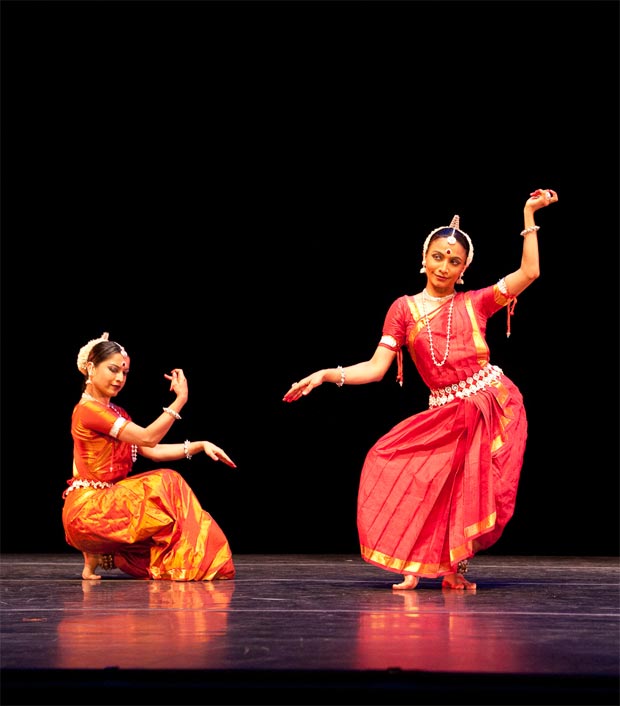
Nrityagram and Chitrasena: Dancing Across Oceans
Nrityagram Dance Ensemble and Chitrasena Dance Company
Odissi and Kandyan dance bill
New York, Joyce Theater
20 March 2012
www.nrityagram.org
www.facebook.com/ChitrasenaDanceCompany
Every performance by the Nrityagram Dance Ensemble feels like a revelation. We are lucky that the company visits New York regularly. Led by the dancer and choreographer, Surupa Sen, and based in an ashram-like “dance village” near the Southern Indian city of Bangalore, these performers, who specialize in the classical Indian dance form, odissi, are both thrilling dancers and mesmerizing actresses. Paired with the musicality of their instrumentalists and singers, they reveal how movement, melody, rhythm, physical beauty and storytelling can find full expression. Even without knowing much about South Asian dance, one cannot help but feel that these are great artists. The ensemble is performing at the Joyce through March 25, with members of the Chitrasena Dance Company from Sri Lanka, specialists in Kandyan Dance.
Odissi, which originated in the state of Orissa in Eastern India, is thousands of years old. There are temple carvings illustrating its poses that date back to the second century BC. Originally, the dances were performed by devadasis – female temple dancers – as part of religious ceremonies dedicated to the cult of Shiva and Vishnu. (The Sanskrit word deva means “deity” and dasi means “servant.”) According to the International Encyclopedia of Dance, of the eight Indian classical dance forms it is the one whose poses most closely resemble those of temple sculptures, many of which illustrate the tribhanga stance, an extreme form of contraposto based on the opposition of different parts of the body. In other words, if the torso leans one way, the head and the hips lean the other, creating a posture that is dynamic, three-dimensional and harmonious. (In ballet, there is a related concept, épaulement.) The body moves in a relaxed, but precise manner, following predetermined patterns for the arms, fingers, hands, head, torso, and legs. The movements are fluid, but can also be punctuated by staccato passages and jumps. The feet have codified positions, but are also used as percussion instruments, creating different sorts of beats (slapping, thumping, etc), intensified by bells attached to the ankles. And then there are the dancers’ eyes, which are constantly changing focus, expressing a wide range of emotions, from surprise to anger to voluptuous love. (One of the most pleasing aspects of Odissi is its unapologetic, wholehearted treatment of sensual love. Many dances depict Radha’s longing for Krishna, and Krishna’s adoration for Radha, despite his wanton ways. Their physical union is a metaphor for harmony in the universe.) One could go on and on; suffice to say that it is an extremely complex, nuanced art, encompassing both pure dance (nrtta) and mime (nrtya).

Odissi dances have fascinated Westerners for a long time. A character costumed as an Indian dancer appeared in Lully’s ballet de cour “Le Triomphe de l’Amour” in 1681, inspired by the publication of the travellogue of a Dutch Missionary who had journeyed to South Asia and witnessed devadasis. Portuguese missionaries re-christened the dancers bayadères, from the verb bailar, to dance. In the late eighteenth century, Goethe wrote a poem, “The God and the Bayadère,” inspired by a Sanskrit play, “The Sign of Shakuntala.” And of course, the heroine of Marius Petipa’s late nineteenth-century ballet, La Bayadère, is devadasi, whose slow, “exotic” dancing contrasts with the rigorous classicism of her rival. To our eye, there is little that resembles Indian dance in Petipa’s choreography for his temple dancer, though he was clearly inspired—as far as an a nineteenth century classicist could be – by the romance of its sinuous lines, contraposto poses, and percussive footwork.
Kandyan dance is the classical dance of Sri Lanka, whose origins lie in the hill country around Kandy, in the center of the teardrop-shaped nation. It too began as religious ritual, a form of spiritual purification performed by men (though it is now performed by both male and female dancers, and the dancers who came to the Joyce were both women). It is far less well known in the West, and was only adapted for the stage in the forties, by Guru Chitrasena, the founder of the Chitrasena company. According to the program notes at the Joyce, Surupa Sen’s idea of bringing Odissi and Kandyan dance together came out of her study of the “Natya Shastra,” an Indian treatise on the performing arts. It got her thinking about the complementary nature of the two art forms. As she writes in the program, she dreamed of “a collaboration…that connects us to our ancient ‘wholeness,’ almost as if the Indian Ocean never separated us.” It’s a lovely idea.
For four years the Chitrasena and Nrityagram dancers have worked together. At the Joyce there were three dancers from Nrityagram, and two from Chitrasena, all women. (All were excellent.) A lush, mellifluous score – for flute, violin, finger cymbals, voice, and drum – was commissioned from the composer Pandit Raghunath Panigrahi. In the segments where both the Sri Lankan and Indian dancers appeared there were two percussionists, each drawing out the rhythms of one dance tradition or the other (both Odissi and Kandyan dance have their own specific rhythmic patterns). Surupa Sen, who has already pushed Odissi in new directions by creating ensemble choreography for what was originally a solo form, has created an absorbing and varied evening of dances—solos, duets, ensembles—that draws on both traditions, a thrilling conversation between two techniques, movement qualities, and styles. In this, she was assisted by the choreographer Hshma Wignaraja, of Chitrasena. As she writes, in her choreography the two styles “[meet] in space, to challenge, combine, and embrace each other through musical conversation and rhythmic dialogue.” And what does this dialogue reveal? Two styles that have much in common—a shared symbolism, for example, and a low center of gravity, as well as a strong rhythmic component, and a desire to charm—but which are also in stark contrast.
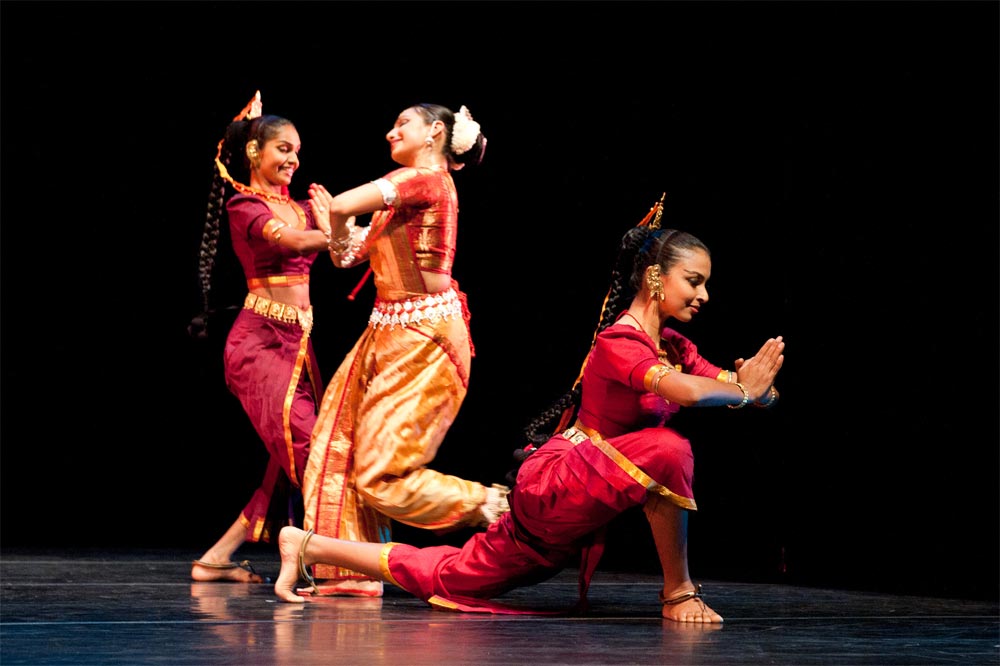
Kandyan dance is more vertical, odissi is all curves; the first is dynamic and muscular, the second fluid, ever-shifting, difficult to pin down; one is more athletic, the other more theatrical and poetic. The contrasts are endless. The Kandyan dancers are younger, and conform more to the idea we have of what dancers should look like: tall, long of limb, lithe, strong. Their costumes reveal more of the body, with bare midriffs and gathered pant-legs showing off their long, powerfully turned-out and angularly bent legs (roughly like a plié in second position, in ballet terms). Their hair is gathered in a long braid at the top of their heads (the end of which is attached, with a ribbon, to the waist of their trousers). The top-knot further elongates their line. By contrast, the odissi dancers wear their hair in thick scrolls at the back of their heads, decorated with flowers. The Kandyan dancers’ arms tend to be extended in long, clean positions, and they use the fingers less. They wear lighter makeup and use their eyes in more straightforward way, and their heads are held more erect, more proudly. They smile more. It is a more direct art form, less coy and complicated than that of the odissi dancers. Their steps are bigger—they cover much more ground – and they raise their feet higher with each step; their jumps are more powerful. If odissi tends toward legato, adagio movement, Kandyan dance opts more for staccato, allegro. (The odissi dancers seemed to use a greater variety of foot positions, sometimes pointing their toes, sometimes flexing, and everything in between.) And the Sri Lankan dancers use their chests differently, sometimes pulsing them slightly to complement the rhythms of their feet and legs—this gives the dance a more “folk-dance like” feel. There is a lot of joy in their dancing—their beaming smiles reflect not only an esthetic choice, but also the physical pleasure of movement.
The odissi dancers, in contrast, are more controlled, more artful, less direct. Each dance is a story—even when it contains no narrative – told with every part of the body, from the eyes to the tip of a finger and toe. Nothing is left to chance. But the combination of the two styles is very pleasing, because we get the muscularity and dynamism of one crossed with the intricacy and nuance of the other. The two enter a lively back-and-forth, in which the eye is drawn first to one dancer, and then to another, always with admiration and fresh interest. One of Surupa Sen’s many talents as a choreogapher is that she manages to create contrasts – especially in cameo-like solos and conversational duets -while preserving flow and a sense of momentum. Each group respects and enjoys the artistry of the other, without any temptation to imitate. In the final piece of the evening, there was a charming passage in which two odissi and one Kandyan dancer mimed a game of dice. The Kandyan dancer started off the game, throwing the imaginary dice lustily, eyes widening with delight at every winning roll. Meanwhile, the other two observed and plotted. With cunning, they stole the dice; the Kandyan dancer’s eyes flashed with anger as she pursued and berated them. In the end, the two graceful tricksters gave in, and all was forgiven. This little scene perfectly captured the give and take between the two companies.
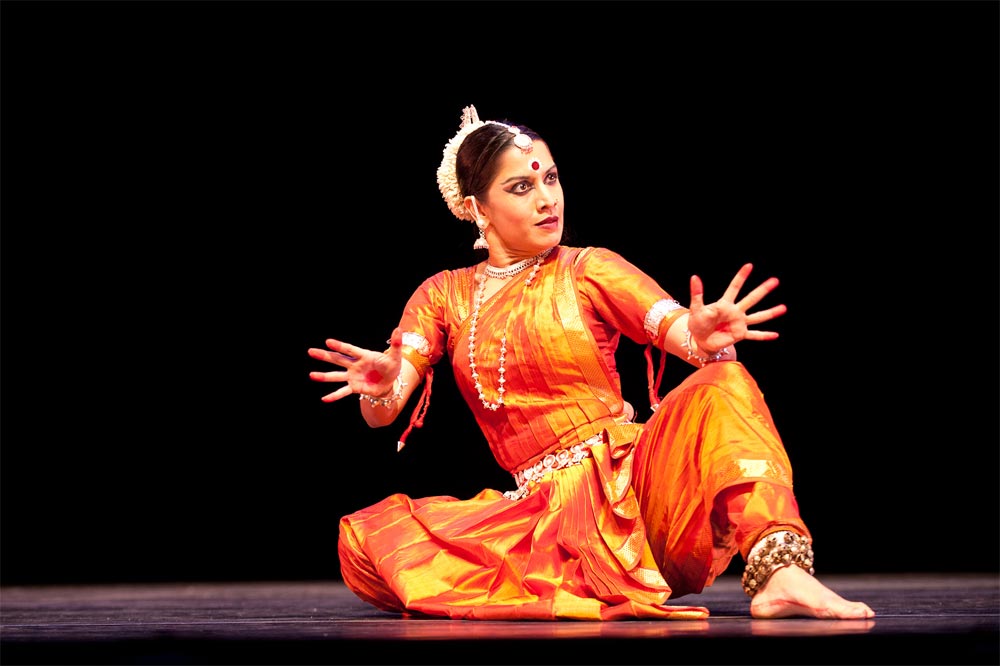
Not all the dances were combined, however. Surupa Sen performed a magical mime solo in which she acted out a jealous scene between Krishna and Radha, followed by Krishna’s guilty plea for forgiveness, all based on a twelfth century poem. As she mimed the words “you are the universe…the limpid crescent moon resting in your hair,” her eyes softened, her fingers traced the delicate line of the moon, and then shimmered around her body. She seemed to emanate light. Time stopped. Not many dancers, in any style, can manage this.
The Nrityagram Dance Ensemble will be performing at the Joyce through March 25: Nrityagram Joyce performances page











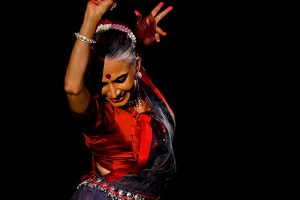
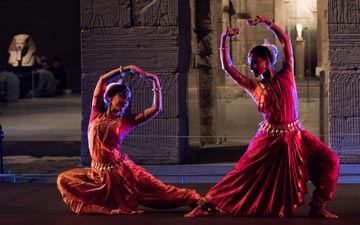
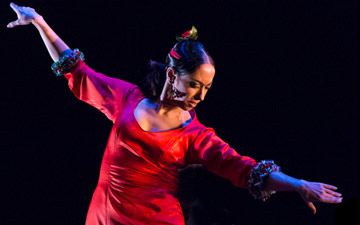
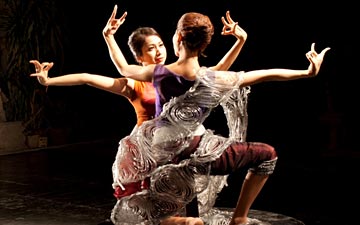


Marine Harss’ review is both informative and graceful, indicating substantive
knowledge on a dance subject dear to my heart for many years. Maseltov!.
Dear Renée, thank you for your comment. And I hope Nrityagram comes to San Francisco soon so you get to enjoy them as well! Best, M
Thank you for this article! Even though I’m nowhere near New York (i.e. had no chance of seeing the show) this was lovely to read. I especially appreciate the detailed descriptions of Odissi and Kandyan dances; it’s interesting to see how you view them, having a strong grounding in dance but from a different culture/tradition. I found the invocations of ballet intriguing. (I’m more familiar with Indian dances than ballet, and this article made me realize they perhaps have more in common than I knew.)
[…] (from Eastern India) and Kandyan Dance (from Sri Lanka). You can read my review, for DanceTabs, here. Here’s a short excerpt: “Surupa Sen performed a mime solo in which she acted out a […]